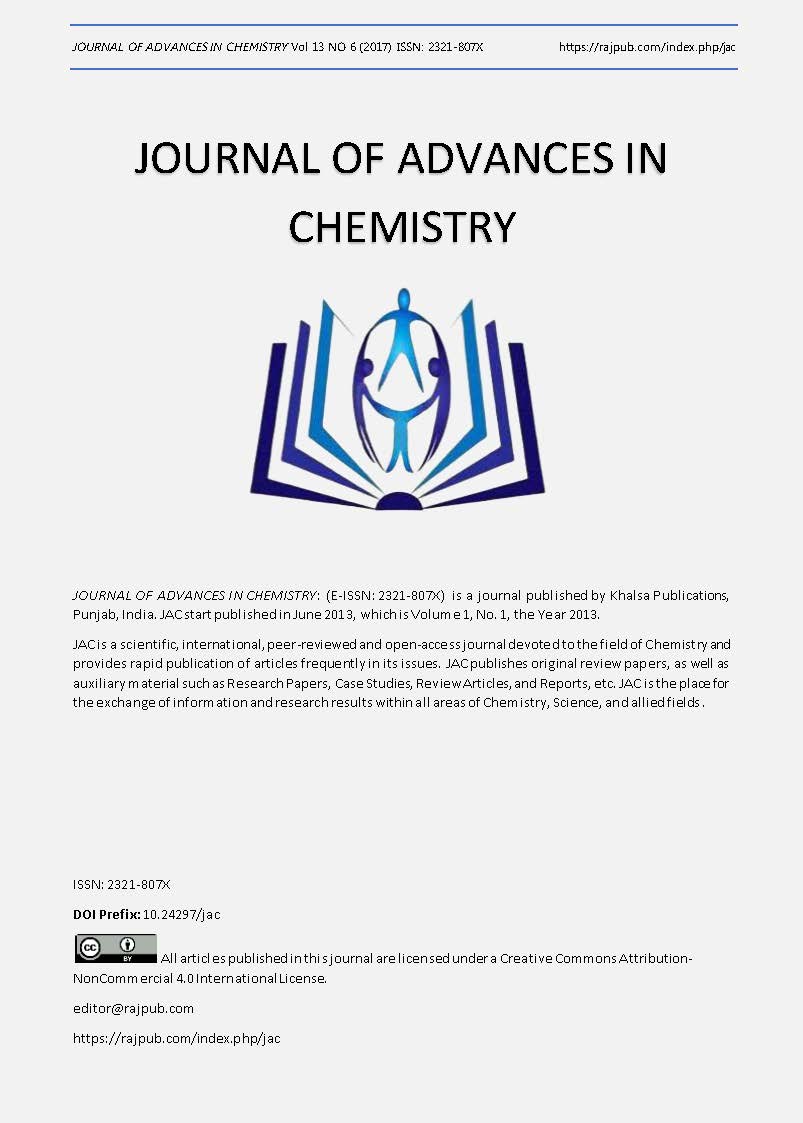SAMPLING AND ANALYSISING OF DISSOLVED OXYGEN IN WATER SAMPLES COLLECTED AT SUNDARAPURAM IN COIMBATORE DISTRICT
DOI:
https://doi.org/10.24297/jac.v13i6.4402Keywords:
Water pollution, Dissolved oxygen, Total Hardness, Aeration, Temperature, Coimbatore pond.Abstract
Maintenance of dissolved oxygen at saturated level will help the growth and reproduction of normal population of fish and other aquatic organisms1,2. Due to increase of industries, it is necessary to monitor the DO level of water resources. This will help us to understand the present condition of water at various resources that are connected to the industries. In this study the water is collected from various resources around Sundarapuram in coimbatore district and they were subjected to dissolved oxygen study. The DO results of various samples were compared with DO of demineralised water which is taken as reference. Parameters such as temperature, hardness and aeration time that will affect the saturation level of DO are also discussed 6,7,8.Â
Downloads
References
2. Metchell and Stapp 1992. Field Manual forwater quality Monitoring.
3. Introduction to Environmental Engineering and Science. Gilbert M. Masters Wendell. P. Ela. Pearson Education.
4. Environmental Science, Miller, South Western publishing.
5. Engineering Chemistry, Harish Kumar Chopra, Anupama Parmar, Narosa Publishing house.
6. Textbook of Engineering Chemistry, C.Parameswara, C.V. Agarwal, Andhranaidu.
7. Engineering Chemistry, Daniel Yesudian, Hitech Publishing.
8. Engineering Chemistry, T. Hemalatha, M.Mariappan, R.K. Publisher
9. Environmental Science and Engineering, Anubha Kaushik – CP Kaushik, New Age International publication.
10. Engineering Chemistry, B. Sivashankar, The McGraw Hill Company.
11. Mortiner.C.H 1956, The Oxygen content of Air Saturated fresh water and Aids in calculating percentage saturation, Interm Association.
12. Introduction to Environmental Science Inquiry Raman Sivakumar
13. Dissolved Oxygen water treatment – Lenntech
14. The Skeptical Environmentalist measuring the real state of the world, Bijorn Comborg.
15. United State Geogological Survey (USGS), 1998, National Field Manual for the collection of water quality data.
16. Michand.J.P. 1991, A citizen guide to understanding and monitoring lakes and streams. Washington State. Department of Ecology publication, Olympia, W.A. USA.
17. Fisheries and Aquatic Science (SFRC), Pond Management Francis Floyd, Ruth. University of Florida.
18. Centre for Environmental Quality, Environmental Engineering and Earth Science. Wilkes University.
19. Chesapeake Bay program, A watershed patnership.
20. Standard Method for the Examination of Water and waste water. Kentucky water watch.
21. Watershed (water, soil and hydro environmental decision support system).
22. Environmental Science of Engineering, P. Anandan & R.Kumaravelan Scitech Publications (India) Pvt. Ltd.
23. Environmental Chemistry, Dr. Saradha Sinha, Golgotia Publication.
24. Water quality and Dissolved Oxygen Science Junction, NC State University.
25. Hesh J.D, 1985 study and interpretation of the chemicals, characterstics of Natural Water, third edition, U.S. Geological Survey Water, Supply paper 2254.
26. Principles of Environmental Science. Inquiry and Applications. William P. Cunningham, University of Minnesota. Mary Ann Cunningham Vasar College. Tata McGraw Hill Publishing Company Limited.
27. Environmental Science and Engineering, Benny Joseph, Tata McGraw Hill.
28. Environmental Studies from Crisis to cure, R.Rajagopalan.
29. Aqua Plant, Department of Wild Life and Fisheries Science, Texas A & M University.
30. Dissolved Oxygen and Corrosion, Corrosion Engineering Companion, McGraw Hill.
31. Dissolved Oxygen – Water Treatment Solution – Lenntech.
32. Giller Paul.S & Malmquvist Bjorn , 1998, The Biology of Stream & River, Oxford University Press.
33. Caduto – Michael J 1990, Pond & Look, University Press New England.
34. The Basic Standard and Methodologies for Surface water , Colorado Department of Public Health and Environment.
35. Jacobson C, 1991 water, water everywhere, second edition produced by Hatch Company.
36. A Citizen Guide to Understanding and Monitoring Lakes and Streams, Department of Ecology, State of Washington.
37. Southern Regional Aquaculture Center Measuring Dissolved Oxygen concentration in Aqua Culture, John A Hargreavaves & Craig S.Tucker.
38. Sample Method, Introduction to Environmental Science, second Edition, Mohan, Joseph M.Morgan, Michal D & Wiersma, James H (1980). W.H. Freeman & Company, NewYork.
39. Standard Method of Examination of Water and Wastewater, Amer Publication, Health Association.
40. Moore .M.L.1989 NALMS Management guide for lakes and reservoir North American lakes management society.
41. American Public Health Association 1998, Standard methods for the estimation of water and waste water 20th Edition.
42. Carpenter J.H.(MES) The Chesapeake Bay Institute Technique for the winkler oxygen method Limnol oceanoger.
43. Grasshoff K.Ehrhardf U and kremling (1983) Method of seawater Analysis, Grasshoff Ehrhardf and Kremling education Verlog Chemi GMbH
44. Murrany J.N.Riley J.P.and Wilson T.R.S (1968) the solubility of oxygen in winkler reagent used for the determination of 2 dissolved oxygen.
45. Environmental Chemistry, A.K.DE Newage International Publisher.
46. National Field Manual for the collection of water quality data (TWRI) Book Revised by Michael E. Lewis.
47. Winkler Test for Dissolved Oxygen, Wikiepedia, Encyclopedia.
48. Laringa T & Writer J, 1997 Boulder Greek watershed education, Teacher’s Resource Guide City of Boulder Water quality and Environmental Service.
49. Neveda Division of Water Planning Water words Dictionary.
50. United State Environmental Protection Agency (USEPA), Terms and Environment.
Downloads
Published
How to Cite
Issue
Section
License
 All articles published in Journal of Advances in Linguistics are licensed under a Creative Commons Attribution 4.0 International License.
All articles published in Journal of Advances in Linguistics are licensed under a Creative Commons Attribution 4.0 International License.




